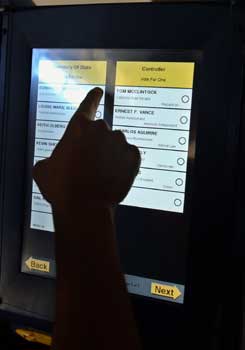| Home | Blog | Ask This | Showcase | Commentary | Comments | About Us | Contributors | Contact Us |

The perils of paperless e-votingASK THIS | July 189, 2005Let’s say your state or local election officials have a paperless e-voting system or are thinking about switching to one. Here are some questions you should ask to see if they’ve really thought it through. By David Dill Q. There has been a lot of controversy about electronic voting in the last few years. In particular, it seems that many experts in computer technology have grave concerns about the trustworthiness of paperless electronic voting. Have you sought advice from computer experts? Have you spoken with experts opposed to paperless systems? (The answer is almost certainly "no", but if it is "yes", who were they, and why did you not find those arguments convincing?) Q. There have been several cases in the last few years where paperless systems have irretrievably lost votes. Suppose that the vote totals reported by the machines seem suspicious. How are you going to do a recount? (If the answer is that they'll print the paper ballots from memory and count them, the obvious follow up is: Why would this satisfy a candidate? If the votes were not recorded properly, won't the paper printouts have the same problems as the electronic records? That's not the same as recounting ballots that the voter was able to check, is it?) Q. At this point, over 20 states have passed laws requiring voter verified paper records, and there are several bills pending in the U.S. Congress that would do the same. Aren't you bucking a trend here? What will you do if a paper ballot requirement is imposed in the future? Q. Unlike paperless systems, precinct-count optical scan systems call for voters to fill out a ballot and put it in a scanner, which counts the votes and stores the ballot in a secure manner. There is strong evidence that such systems are not only much less expensive to acquire, but less costly to maintain, than paperless systems. For example, Hundreds of computer technologists and thousands of others have endorsed this resolution, which concludes that unauditable voting equipment will erode confidence in our elections, causing further disillusionment of the voting public.
stored internally. Voter verified paper ballots (VVPB): A paper ballot that the voter can inspect before casting. The votes on the paper ballots themselves are counted. Optical scan systems: The ballot is like a standardized exam. The voter fills in "bubbles" or inks in a gap in an arrow. The ballots are counted by machine, either in the central office or at the precinct. Precinct Count Optical scan: An optical scan system where the ballot scanner is in the precinct. The voter or someone else puts the ballot in the scanner, which counts the votes and stores the ballot in a secure manner. If so configured, the machines can reject the ballot if it can't be read properly. Precinct count systems have been studied extensively by political scientists, who have found them to be much less conducive to voter error than punch cards. In this respect they are competitive (perhaps better) than DREs. Precinct count optical scan systems are very widely used in the Voter verified paper records (or audit trails): A paper record of the vote that the voter can inspect before casting. Votes can be stored and counted electronically, but the paper records are available for manual audits or recounts.
|




